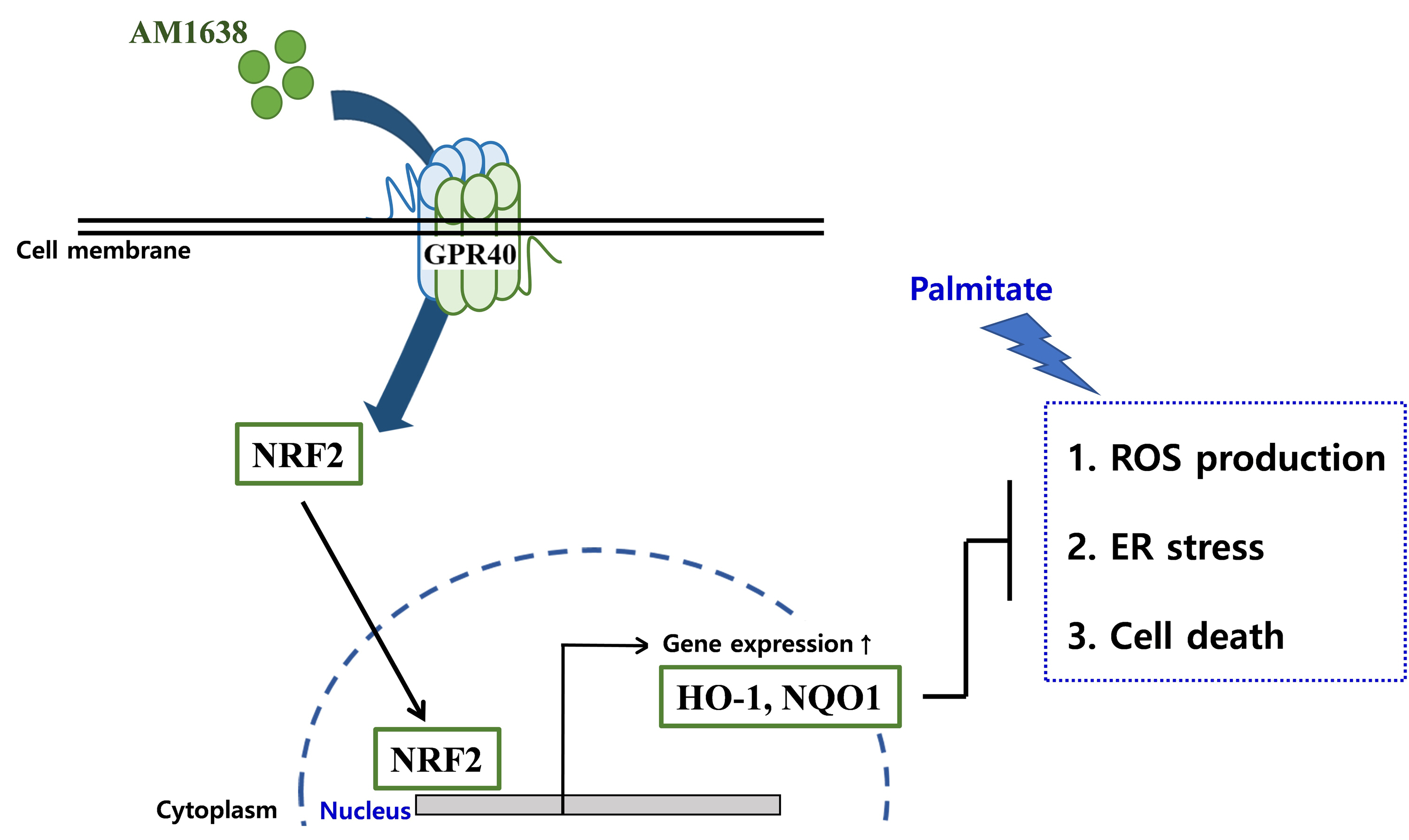Search
- Page Path
- HOME > Search
Original Articles
- Miscellaneous
- AM1638, a GPR40-Full Agonist, Inhibited Palmitate- Induced ROS Production and Endoplasmic Reticulum Stress, Enhancing HUVEC Viability in an NRF2-Dependent Manner
- Hwan-Jin Hwang, Joo Won Kim, SukHwan Yun, Min Jeong Park, Eyun Song, Sooyeon Jang, Ahreum Jang, Kyung Mook Choi, Sei Hyun Baik, Hye Jin Yoo
- Endocrinol Metab. 2023;38(6):760-769. Published online November 2, 2023
- DOI: https://doi.org/10.3803/EnM.2023.1774

- 1,386 View
- 88 Download
-
 Abstract
Abstract
 PDF
PDF PubReader
PubReader  ePub
ePub - Background
G protein-coupled receptor 40 (GPR40) is a key molecule in diabetes and fatty liver, but its role in endothelial dysfunction remains unclear. Our objective in this study was to determine whether GPR40 agonists protect endothelial cells against palmitatemediated oxidative stress.
Methods
Human umbilical vein endothelial cells (HUVECs) were used to investigate effects of various GPR40 agonists on vascular endothelium.
Results
In HUVECs, AM1638, a GPR40-full agonist, enhanced nuclear factor erythroid 2–related factor 2 (NRF2) translocation to the nucleus and heme oxygenase-1 (HO-1) expression, which blocked palmitate-induced superoxide production. Those antioxidant effects were not detected after treatment with LY2922470 or TAK875, GPR40-partial agonists, suggesting that GPR40 regulates reactive oxygen species (ROS) removal in a ligand-dependent manner. We also found that palmitate-induced CCAAT/enhancer‐binding protein homologous protein expression; X-box binding protein-1 splicing, nuclear condensation, and fragmentation; and caspase-3 cleavage were all blocked in an NRF2-dependent manner after AM1638 treatment. Both LY2922470 and TAK875 also improved cell viability independent of the NRF2/ROS pathway by reducing palmitate-mediated endoplasmic reticulum stress and nuclear damage. GPR40 agonists thus have beneficial effects against palmitate in HUVECs. In particular, AM1638 reduced palmitate-induced superoxide production and cytotoxicity in an NRF2/HO-1 dependent manner.
Conclusion
GPR40 could be developed as a good therapeutic target to prevent or treat cardiovascular diseases such as atherosclerosis.

- Antibody-dependent Cell-mediated Cytotoxitity as a Prognostic Indicator in the Medical Treatment of Graves' Disease.
- Kwan Woo Lee, Young Goo Shin, Hye Rim Ro, Sung Kyu Lee, Yun Suk Chung, Hyun Man Kim, Yoon Jung Kim, Eun Kyung Hong, Bong Nam Chae
- J Korean Endocr Soc. 1998;13(4):554-562. Published online January 1, 2001
- 1,068 View
- 19 Download
-
 Abstract
Abstract
 PDF
PDF - BACKGROUND
The several forms of treatment of Graves disease-thyroidectomy, antithyroid drugs and radioiodide therapy-are in wide use now. But which therapy is best is a matter of debate. Some authors reported that in patients who underwent thyroidectomy, higher titers of serum antimicrosomal antibody were associated with 1) higher formation rates of germinal centers, 2) more lymphocyte infiltration in the thyroid tissue, 3) higher incidence of hypothyroidism, and 4) lower incidence of recurrence. We were interested in the relationship of thyroid autoantibody titers, ADCC(antibody-dependent cell-mediated cytotoxicity) activity and the clinical response to antithyroid medication. METHODS: We measured ADCC activities from patients in Graves disease(n-48), Hashimoto thyroiditis(n=17) and normal control(n=9). The patients of Graves disease were followed up for more than 1 year, and they were grouped into A(n=17, well responsed group to antithyroid medication) and B(n=31, poorly responsed group). We examined ADCC activities of patients' sera by chromium release assay. RESULTS: 1) Mean age of patients with Graves disease was 34.4210.4 years and 15 patients were male(31%). 2) Results of thyroid function tests of the Graves' patients were T 585.9 +/- 255.3 ng/dL, T4 21.3 +/- 12.2 mg/dL, TSH 0.11 +/- 0.06mIU/mL. Concentrations of antimicrosomal antibody, antithyroglobulin antibody and thyrotropin binding inhibitory immunoglobulin were 1279.1 +/- 1486.7 IU/mL, 488.1 +/- 751.1 IU/mL, and 38.5 +/- 33.4U/L respectively. 3) There was no significant difference between levels of thyroid hormones or concentrations of thyroid autoantibodies and ADCC activities in graves patients. 4) The ADCC activity of the Graves patient group(24.49%) was significantly higher than that of the normal control group(3.76%), and significantly lower than that of the Hashimotos thyroiditis group(36.34%). 5) There was no significant difference in ADCC activity between group A(18.24 +/- 13.44%) and B(27.91 +20.02%). CONCLUSION: From this results, we suggested that ADCC activity seems to be no value as a prognostic factor in predicting the response to antithyroid drugs in Graves disease patients. But, further studies, larger number of patients and long-term follow up, are needed.


 KES
KES
 First
First Prev
Prev



